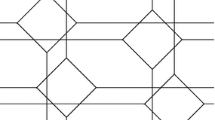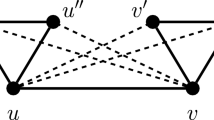Abstract
Given a set ofn demand points with weightW i ,i = 1,2,...,n, in the plane, we consider several geometric facility location problems. Specifically we study the complexity of the Euclidean 1-line center problem, discrete 1-point center problem and a competitive location problem. The Euclidean 1-line center problem is to locate a line which minimizes the maximum weighted distance from the line (or the center) to the demand points. The discrete 1-point center problem is to locate one of the demand points so as to minimize the maximum unweighted distance from the point to other demand points. The competitive location problem studied is to locate a new facility point to compete against an existing facility so that a certain objective function is optimized. An Ω(n logn) lower bound is proved for these problems under appropriate models of computation. Efficient algorithms for these problems that achieve the lower bound and other related problems are also given.
Similar content being viewed by others
References
A. V. Aho, J. E. Hopcroft, and J. D. Ullman.The Design and Analysis of Computer Algorithms. Addison-Wesley; Reading, MA, 1974.
M. Ben-Or. Lower bounds for algebraic computation trees,Proc. 15th Annual Symp. on Theory of Computing, 1983, pp. 80–86.
P. Dobkin and R. J. Lipton. On the complexity of computations under varying sets of primitives,J. Comput. System Sci. 18 (1979), 86–91.
Z. Drezner. Competitive location strategies for two facilities. In: tRegional Science and Urban Economics, Vol. 12, Elsevier: North-Holland, 1982, pp. 485–493.
H. Edelsbrunner, L. J. Guibas, and J. Stolfi. Optimal point location in a monotone subdivision.SIAM J. Comput. (to appear).
J. Elzinga and D. W. Hearn. Geometrical solutions for some minimax location problems.Transportation Sci.,6 (1972), 379–394.
M. L. Fredman and B. Weide. On the complexity of computing the measure of U[a i,b i],Commun. ACM,21, 7 (July 1978), 540–544.
R. L. Graham. An efficient algorithm for determining the convex hull of a finite set.Inform. Process. Lett,1 (1972), 132–133.
S. L. Hakimi. “On locating new facilities in a competitive environment,”ISOLDE II, June 1981, Skodsberg, Denmark.
M. E. Houle and G. T. Toussaint. Computing the width of a set,ACM Symp. on Computational Geometry, Baltimore, Maryland, 1985, pp. 1–7.
D. G. Kirkpatrick. Optimal search in planar subdivisions.SIAM J. Comput. 12, 1 (Feb. 1983), 28–35.
D. T. Lee. Farthest neighbor Voronoi diagrams and applications. Tech. Rep. #80-11-FC-04, Dept. EE/CS, Northwestern University, Nov. 1980.
D. T. Lee and C. C. Yang. Location of multiple points in a planar subdivision,Inform. Process. Lett. 9, 4 (Nov. 1979), 190–192.
U. Manber and M. Tompa. The complexity of problems on probabilistic, nondeterministic and alternating decision trees.J. ACM 32, 3 (1985), 720–732.
N. Megiddo. Linear-time algorithms for linear programming in R3 and related problems,SIAM J. Comput.,12, 4 (1983), 759–776.
N. Megiddo and A. Tamir. On the complexity of locating linear facilities in the plane,Oper. Res. Lett. 1 (1982), 194–197.
J. G. Morris and J. P. Norback. Linear facility location-Solving extensions of the basic problem.European J. Oper. Res.,12, (1983), 90–94.
F. P. Preparata. A note on locating a set of points in a planar subdivision.SIAM J. Comput.,8, 4 (1979), 542–545.
F. P. Preparata and S. J. Hong. Convex hulls of finite sets of points in two and three dimensions.Commun. ACM,20, 2 (1977), 87–93.
E. M. Reingold. On the optimality of some set algorithms,J. ACM,19, 4 (1972), 649–659.
M. I. Shamos. Problems in computational geometry, Dept. Comput. Sci., Yale University: New Haven, CO, May 1975.
M. I. Shamos and D. Hoey. Closest-point problems.Proc. IEEE 16th Symp. Foundations of Comput. Sci., 1975, pp. 151–162.
G. T. Toussaint. Solving geometric problems with the rotating calipers.Proc. of IEEE MELECON, Athens, Greece, 1983.
Author information
Authors and Affiliations
Additional information
Communicated by Leonidas. J. Guibus.
Supported in part by the National Science Foundation under Grants ECS 83-40031 and DCR 84-20814.
Rights and permissions
About this article
Cite this article
Lee, D.T., Wu, Y.F. Geometric complexity of some location problems. Algorithmica 1, 193–211 (1986). https://doi.org/10.1007/BF01840442
Received:
Revised:
Issue Date:
DOI: https://doi.org/10.1007/BF01840442




